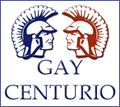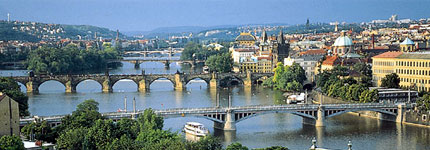|
City Community
Accommodations
Associations
Bars
Cafes
Cinemas
Dance Clubs
Erotic
Escorts
Gay Info
Restaurants
Saunas
Shops
Travel Tours
Women's Places
 Download Maps Download Maps
 Download Movies Download Movies









www.gaypower.info
www.centurio.com
www.gayhermes.com
www.matunda.de
www.gaysado.de
www.gaymaso.de
www.maob.com
www.nocreditcardgay.de
 


|


[english] [español] [français] [deutsch] [italiano]
Prague (Czech Praha),...
...capital and largest city of the Czech Republic, located in the west central part of the country, in the region of Bohemia. Often called the City of a Hundred Spires because of its many churches and towers, Prague is the chief commercial, industrial, and cultural center of the Czech Republic. Unlike much of central Europe, the city was not seriously damaged in World War II (1939-1945) and remains one of the most beautiful cities on the continent. From 1918 to 1993 Prague was the capital of Czechoslovakia, which came under Communist control after World War II. Since the fall of Communism in 1989, Prague has become a major tourist attraction, bolstering the city’s economy.
Greater Prague, which covers an area of 496 sq km (192 sq mi), was formed in 1920 by the incorporation of 37 nearby towns and villages. Greater Prague also includes numerous new suburban developments dominated by high-rise apartments that date from the Communist era.
The historic center of the city developed in a broad valley on the banks and surrounding hills of the Vltava River. Many bridges link the two parts of the city. The most famous of these is the Charles Bridge, commissioned in the late 14th century by Holy Roman Emperor Charles IV, completed in the early 15th century and later embellished with statues of saints. Old Town, founded in the 13th century, and New Town, which developed in the 14th century, lie on the eastern bank of the river. Old Town contains many important architectural and artistic monuments, several of them situated on Old Town Square. A statue of John Huss (Jan Hus), the Bohemian religious reformer who instigated the Protestant Reformation in the 15th century, dominates the square. Other attractions are the 14th-century Týn Church, a center of the Hussite movement, and the astronomical clock, or Orloj, of Old Town Hall (Staromestská Radnice), which is adorned with statues of the 12 apostles that rotate each hour. Old Town also encompasses Josephov, the city’s Jewish quarter. Dating from the 10th century, Josephov contains the Old-New Synagogue and the Old Jewish Cemetery, which is the oldest in Europe. Many of the buildings of Charles University are in Old Town, as are several concert halls and museums.
New Town, which is adjacent to Old Town on the eastern bank of the Vltava, has remained an industrial and commercial center over the centuries. Many of the area’s buildings date from the 18th century. There are also numerous examples of art nouveau architecture. The famous Wenceslas Square, or Václavské námestí, is presided over by a statue of Saint Wenceslas, the 10th-century nobleman celebrated in the Christmas carol “Good King Wenceslas.” The National Museum, built between 1885 and 1890, lies at one end of the square. The National Theater, completed in 1881, is located on Národní trida, or National Street. Both buildings were constructed during the period of resurgent Czech culture and nationalism in the 19th century.
The city’s population has declined since the end of Communism. The increased costs of raising children in a market economy and new career and travel opportunities available to young people have led to a drop in the birthrate. Government restrictions on migration into Prague were abolished after 1989. However, difficulties in finding housing and the higher cost of living have limited in-migration. Approximately 68,000 foreigners have residence permits to live in Prague.
The majority of Prague’s residents are Czech. In earlier centuries, many Germans lived in the city. The ruling Premyslid dynasty of Prague encouraged German migration to Bohemia in medieval times. When Prague became the capital of the newly created Czechoslovak Republic in 1918, approximately 35 percent of the city’s inhabitants were German-speakers. Many of these were members of Prague’s large Jewish community, which dated to the 10th century. Nearly all of the city’s Jews perished in the Holocaust. After World War II, most other German-speakers in Prague were among the approximately 3 million Germans expelled from the country. Most Czechs are nominally Catholic. Czech culture has also been shaped by a strong Protestant influence dating from the times of Huss, the Czech religious reformer burned at the stake as a heretic in 1415.
Prague is the Czech Republic’s main industrial center. With the spread of the Industrial Revolution in the 19th century, the city became one of the most heavily industrialized cities in Europe. This trend continued during the interwar period, and today most people remain employed in industry. Since the fall of Communism, Prague has also developed rapidly as a commercial and financial hub. The number of people employed in the service sector has grown. The city also has turned into a major European tourist destination.
Metal products and machinery, including aircraft engines, automobiles, diesel engines, machine tools, refined oil products, and electronics are the city’s most important products. Prague also produces significant amounts of beer, chemicals, and processed foods.
Prague has a modern subway system and a well-developed network of buses and trams. The number of passenger cars has increased greatly since a market-based economy was introduced in 1989. Cars are banned from much of the center of the city, which is part of a protected urban historical zone. With three main passenger stations and three freight stations, Prague is one of the Czech Republic’s railway centers. Rapid trains now link the city to major European centers. The international airport at Ruzyne has been modernized since 1989.
Prague is also the Czech Republic’s main communications center. Approximately ten daily newspapers are published here. A free press has developed since 1989, and many daily newspapers and magazines are privately owned. While the broadcast media have been slower to privatize, there are now two private television and several private radio stations. The English-language Prague Post has become an important source of information for the city’s English-speaking community.
The city of Prague had a population of 1,178,576 in 2001.
"Prague," Microsoft® Encarta® Online Encyclopedia 2004
http://encarta.msn.com © 1997-2004 Microsoft Corporation. All Rights Reserved.
|
